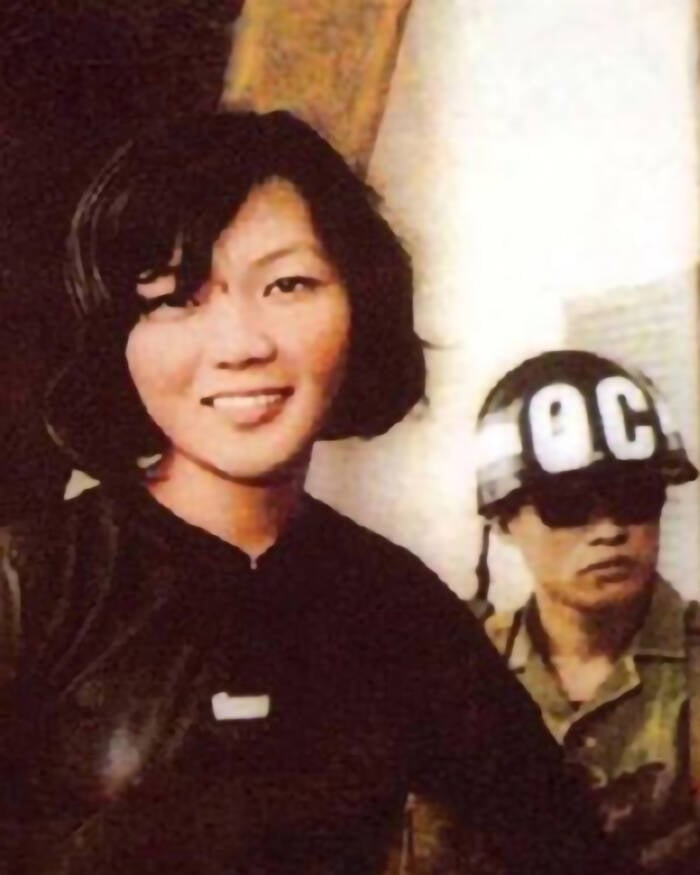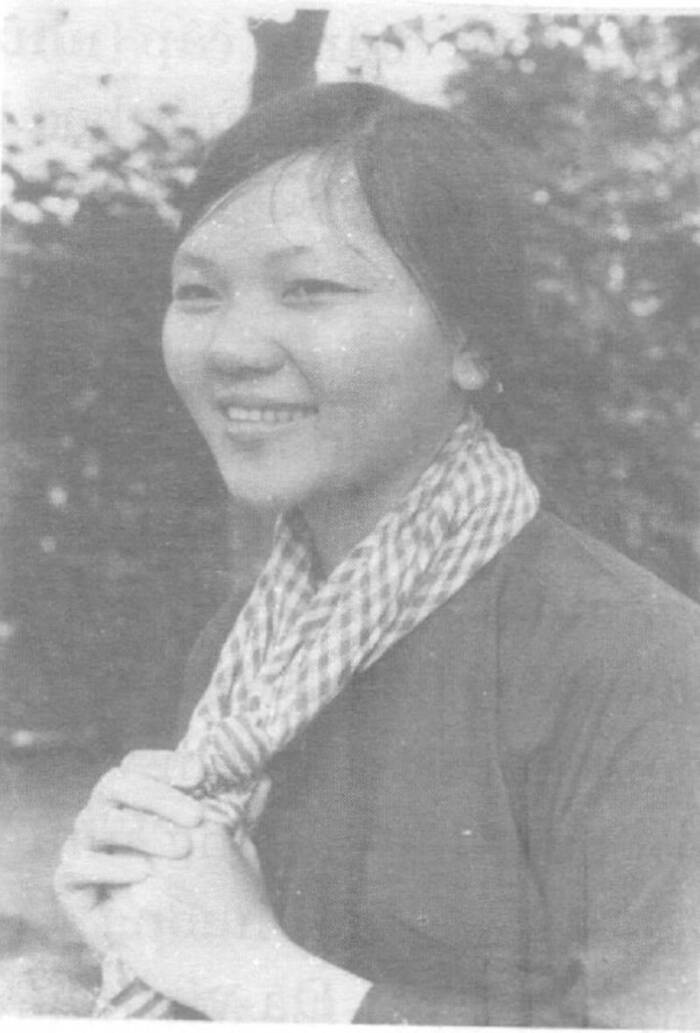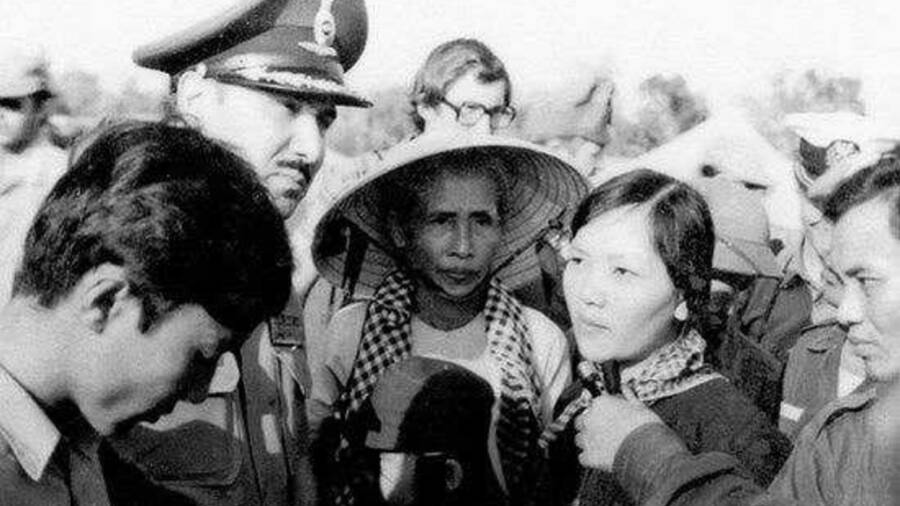Captured by South Vietnamese forces in 1968 and punished with 20 years of hard labor, Võ Thị Thắng was famously joyful at her sentencing — confident that South Vietnam would fall long before her sentence was over.

Fair UseVõ Thị Thắng (sometimes formatted as Vo Thi Thang) in the “Smile of Victory” photo that made her famous.
In 1968, Võ Thị Thắng was sentenced to 20 years of hard labor. She was only in her early 20s, but the prospect of losing her young adulthood to prison and torture didn’t seem to dishearten her in the slightest. Instead, Thắng smiled brightly. She then demanded to know if the South Vietnamese authorities thought that their government was going to last another 20 years.
It didn’t. Thắng was released from her imprisonment in 1974 after the Paris Peace Accords, and the South Vietnamese government in Saigon fell just a year later in 1975. The government, as she had predicted, did not last. But Thắng’s smile and cutting words remain famous in Vietnam to this day.
This is the story of Võ Thị Thắng, the woman behind the “Smile of Victory.”
How Võ Thị Thắng Became A Revolutionary — And A Would-Be Assassin
Born on Dec. 10, 1945, Võ Thị Thắng grew up in a country at war. France had conquered Vietnam in the 19th century, but the French Indochina War began in 1946 as France struggled to hold onto its colony, and Vietnamese nationals led by Hồ Chí Minh and Võ Nguyên Giáp fought back.
Thắng grew up in the Long An province of Vietnam, in a family that fiercely supported the revolutionary causes of what would be called North Vietnam. She began to actively participate herself at a young age. According to the Vietnam National Authority of Tourism, Thắng spent part of her childhood delivering letters and food to revolutionary soldiers, who her parents hid in a secret tunnel in their garden. When she was 16 years old, she joined the National Liberation Front of South Vietnam, or the Viet Cong.

Vietnam People’s Army Museum SystemViet Minh troops planting a flag on the captured French headquarters at Dien Bien Phu. 1954.
At age 17, Thắng went to Saigon. As American involvement in Vietnam escalated, Thắng joined the Ho Chi Minh Communist Youth Union and the Vietnamese Students’ Association, both of which were banned in Saigon.
The opportunity to do even more came in 1968, when Võ Thị Thắng was ordered to assassinate a suspected spy.
The “Smile Of Victory” During The Vietnam War

Fair UseVõ Thị Thắng (or Vo Thi Thang) in an undated photo.
As the BBC reported, Võ Thị Thắng was tasked with assassinating an alleged “secret agent” named Trần Văn Đỗ. So on July 27, 1968, Thắng broke into Do’s house. Finding him in bed, she raised her gun — and fired.
However, she failed to kill her target.
She was soon arrested and put on trial for the attempted killing. Later on in 1968, Võ Thị Thắng was sentenced to 20 years of hard labor. According to Vietnamese media, one of her judges purportedly tried to intimidate her by saying that she would be “buried in a dark prison.”
Far from being cowed by his words, Thắng famously retorted: “Will your government last long enough to imprison me for 20 years?”

National ArchivesSmoke billows over Saigon during the Tet Offensive, during which the North Vietnamese Army and the Viet Cong launched numerous devastating attacks.
Thắng ultimately spent less than six years in prison. According to the Vietnam National Authority of Tourism, she was imprisoned at the Thu Duc Prison, the Chi Hoa Prison, the Tan Hiep Prison, the Ho Nai Prison, and the Con Dao Prison, during which time she was also reportedly tortured.
But Võ Thị Thắng remained unbroken. And in the end, her words at her trial proved prophetic. Saigon fell on April 30, 1975. By then, Thắng had already been released under the Paris Peace Accords a year earlier.
Thắng later commented on her famous photo in 2003: “Yes, they have given the photo such a name [as the Smile Of Victory]. But my smile would have meant nothing without an undaunted and indomitable nation behind me.”
Võ Thị Thắng After The Fall Of Saigon
Though the Vietnam War had ended, Võ Thị Thắng continued to live a politically active life. She was honored by the Communist Party, which gave her several awards, and later served in Vietnam’s Party Central Committee and National Assembly. Additionally, she helped handle the Vietnam Women’s Union, and even led the country’s tourism industry.

Fair Use/Liberation RadioVõ Thị Thắng (or Vo Thi Thang) being interviewed by Liberation Radio following her release from prison in 1974.
She died on August 22, 2014, at the age of 68.
Thắng’s story is not well known in the U.S., but it certainly is in Vietnam.
“In this moment of silent farewell, we will never forget the posture, smile, and words of [Thắng] before the enemy’s court… right after hearing the court read the sentence of 20 years of hard labor: ‘How long can your government survive to sentence me to 20 years in prison?'” the Vietnam National Authority of Tourism memorialized her after her death. “[The] question was like a prophecy of the collapse of a brutal regime… Võ Thị Thắng, a daughter of Long An with the ‘Smile of Victory,’ ‘Võ Thị Thắng’s smile’ has become one of the beautiful symbols for the heroic generation in the resistance war for Independence – Freedom – Unification of the country.”
In her homeland, Võ Thị Thắng is seen as a symbol of the resistance — a dedicated fighter who not only accepted her imprisonment with cheer, but responded to it with steely resolve. She told the South Vietnamese judges who sentenced her to 20 years of hard labor that their regime would not last — and it didn’t. In less than a decade, Thắng had walked free from her prison, and South Vietnam had crumbled and ceased to exist.
“Võ Thị Thắng’s posture, smile, and words were once a source of inspiration for many poetic works,” the Vietnam National Authority of Tourism continued, “contributing to encouraging and urging many people to overcome difficulties and move forward; the photo has also crossed national borders, touching the hearts of many international friends… In this moment of sorrow, we express our deepest condolences to the family of Comrade Vo Thi Thang. Farewell, Comrade Vo Thi Thang! May her soul rest in peace and happiness.”
After reading about Võ Thị Thắng, see how the Gulf of Tonkin incident led to a larger U.S. involvement in the Vietnam War. Or, discover the true story of Thích Quảng Đức, the “burning monk” who set himself on fire in Saigon.





